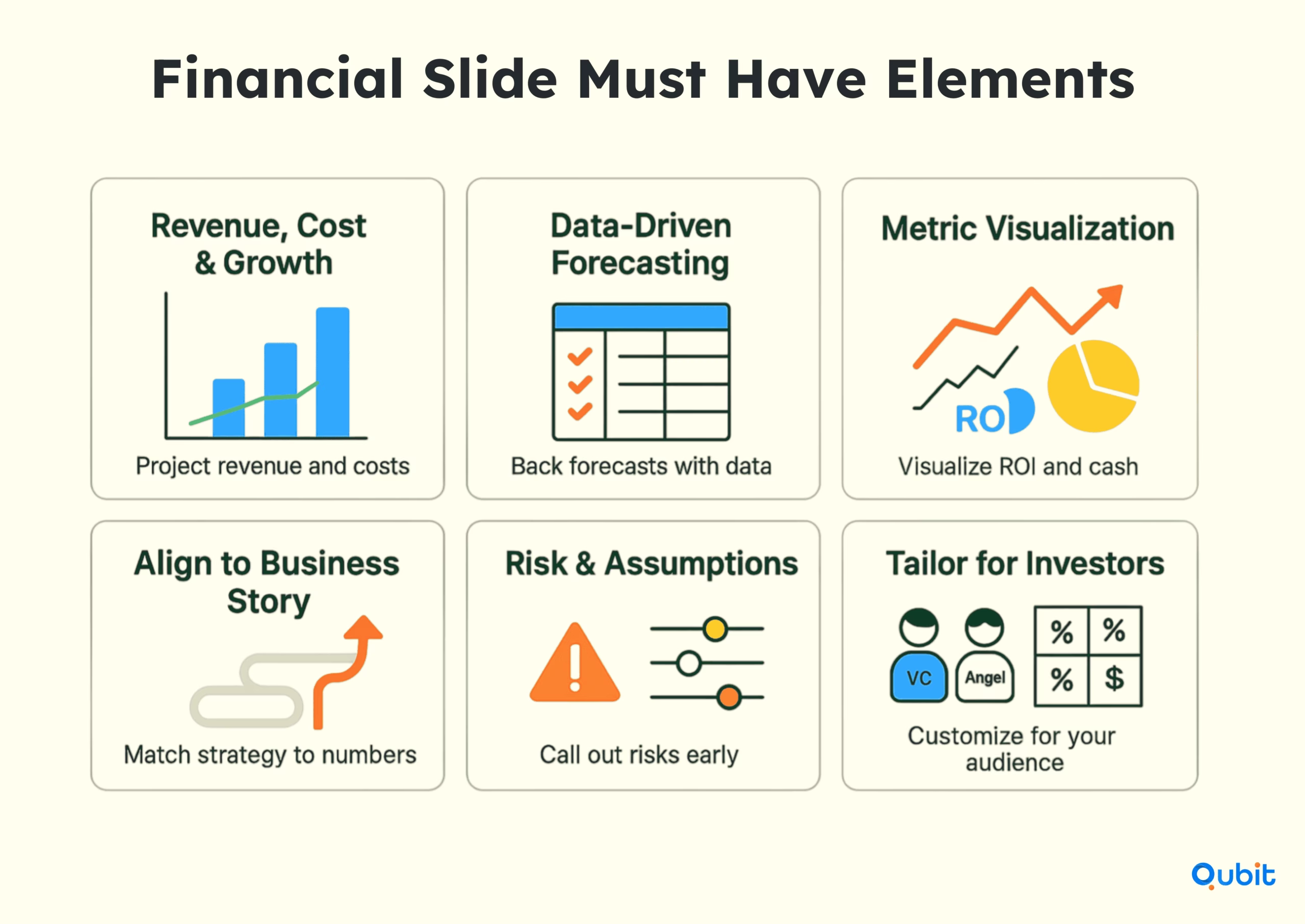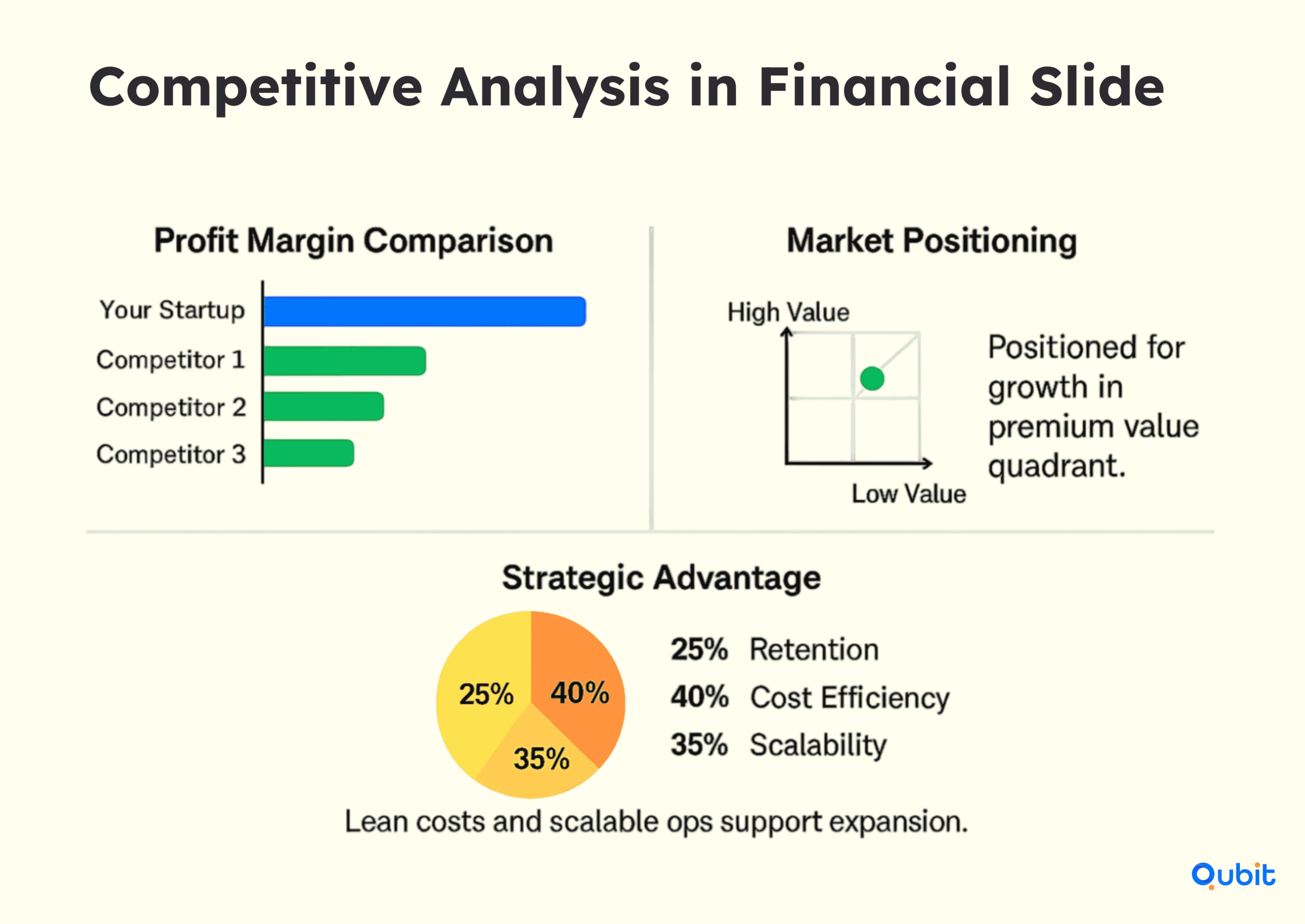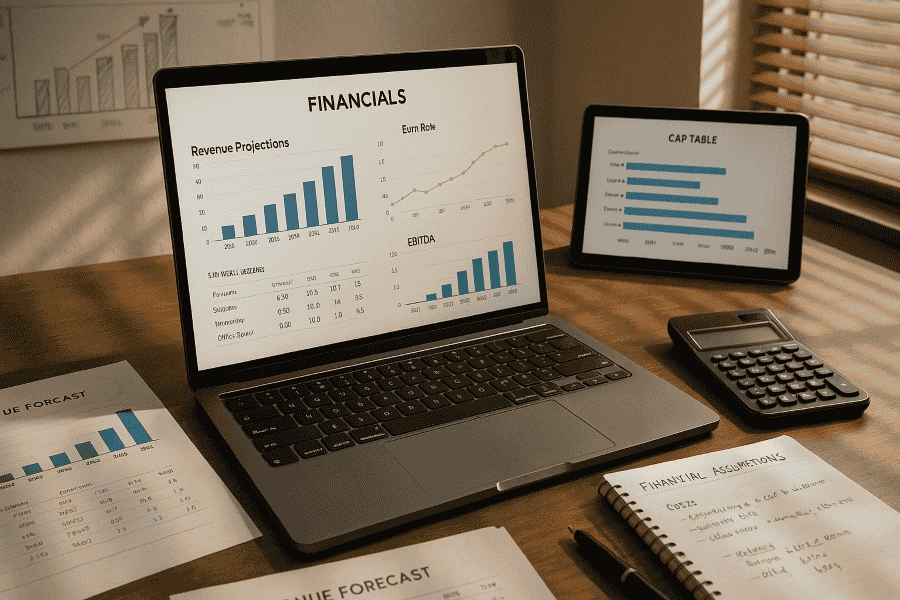Building a standout startup pitch deck hinges on your financial slides—they’re the foundation that proves your business’s viability and growth potential. These slides need just the right mix of clarity and substance, so investors can quickly grasp your financial strategy without getting lost in the details.
When you think about how to create a pitch deck, the financial section anchors the entire narrative. In this guide, we’ll cover the essentials for crafting investor-focused financial slides and pave the way to a deeper exploration of key metrics, forecasting techniques, and data-driven storytelling. Let’s get started!
Financial Slides That Appeal to Investors
Investors expect more than just numbers—they seek a compelling narrative backed by solid financial projections. This section explores the essential components of financial slides that can elevate your startup pitch deck and secure investor confidence.

1. Highlight Revenue, Cost, and Growth Projections
Investors prioritize transparency in financial metrics. Clearly outlining revenue streams, cost structures, and growth trajectories is crucial for building trust. Start by presenting revenue projections in a way that demonstrates scalability. Break down costs into manageable categories, such as operational expenses, marketing budgets, and fixed costs, to show a well-thought-out financial model for your startup.
Growth projections should be realistic yet ambitious. Use historical data, market trends, and industry benchmarks to substantiate your forecasts. For example, if your startup operates in a growing market, emphasize how your product or service aligns with this upward trend.
2. Incorporate Data-Driven Forecasting
Credibility hinges on the accuracy of your financial forecasts. Investors are quick to spot inflated numbers or vague assumptions. To avoid this, base your projections on concrete data sources, such as market research, customer acquisition rates, and competitive analysis.
An overview of the market size slide for pitch deck illustrates how market data integrates with financial projections, offering perspective on industry positioning. By tying your forecasts to tangible data, you demonstrate a deep understanding of your market and reduce perceived risk for investors.
3. Visualize Key Metrics Effectively
Numbers alone can overwhelm or confuse your audience. To make your financial slides more engaging, use visuals such as charts, graphs, and tables. For instance, a line graph showcasing revenue growth over time or a pie chart breaking down cost allocations can simplify complex data.
Ensure that your visuals are clean and easy to interpret. Avoid clutter and focus on the metrics that matter most to investors, such as profitability, cash flow, and return on investment (ROI).
4. Integrate Financial Metrics with Your Business Story
Financial slides should not exist in isolation—they must complement the overall narrative of your startup pitch deck. Investors want to see how your financial projections align with your business model, market strategy, and long-term vision.
The discussion in business portfolio for startups enriches your insight by framing financial data within a comprehensive view of your startup’s strategic presentation. By weaving financial metrics into your broader story, you create a cohesive and compelling pitch that resonates with investors.
5. Address Risks and Assumptions
No financial model is without risks or assumptions. Acknowledging these upfront demonstrates honesty and preparedness. Highlight potential challenges, such as market fluctuations or operational hurdles, and explain your strategies for mitigating them.
Similarly, clarify the assumptions underpinning your projections. For example, if your revenue forecast assumes a specific customer acquisition rate, state this explicitly. Transparency in risks and assumptions builds investor confidence and shows that you’ve considered multiple scenarios.
6. Tailor Slides to Your Audience
Different investors have different priorities. Some may focus on profitability, while others prioritize scalability or market potential. Research your audience beforehand and tailor your financial slides to address their specific interests.
For instance, if presenting to venture capitalists, emphasize growth potential and market share. If pitching to angel investors, focus on ROI and exit strategies. Customization ensures that your financial slides resonate with the unique concerns of your audience.
Qubit Capital’s Financial Model Creation Service
Creating financial slides that appeal to investors can be challenging, but you don’t have to do it alone. At Qubit Capital, we specialize in crafting tailored financial models that showcase your startup’s potential. 👉 Explore our Financial Model Creation Service to elevate your pitch deck and secure investor confidence.
Adapt Your Financial Slides to Fit Different Decks and Highlight Your Competitive Edge
Building financial slides to suit various pitch deck formats is a critical skill for presenting your business effectively. Whether you're preparing an investor deck or a pitch book, refining your content ensures your message resonates with the intended audience. Additionally, integrating competitive analysis into your slides can amplify your narrative, showcasing your unique position in the market.
Understanding the Role of Financial Slides in Different Decks
Financial slides are not one-size-fits-all. Their structure and focus should align with the type of deck you're creating. For instance, an investor deck typically emphasizes growth potential, revenue forecasts, and profitability metrics. On the other hand, a pitch book often dives deeper into financial details, offering granular insights into valuation, historical performance, and market trends.
Insights drawn from pitch deck vs investor deck help you distinguish between different presentation approaches and reveal how financial slides might be tailored to each format. For example, investor decks often prioritize clarity and brevity, while pitch books demand comprehensive data and detailed analysis.
Strategies for Refining Financial Slides
Customize Content for Your Audience
Begin by identifying the priorities of your audience. Investors are likely to focus on projections and ROI, while stakeholders reviewing a pitch book may expect detailed breakdowns of financial statements. Adjust your slides accordingly to highlight the most relevant data.Streamline Visuals for Impact
Use charts, graphs, and infographics to make complex financial data more digestible. For investor decks, opt for simple visuals that emphasize key metrics, such as revenue growth or market share. In pitch books, consider more detailed visuals that provide a deeper dive into financial performance.Highlight Key Metrics
Pinpoint the financial metrics that matter most to your audience. For investor decks, this might include customer acquisition costs or lifetime value. In pitch books, focus on metrics like EBITDA, gross margins, or historical revenue trends.Maintain Consistency Across Slides
Ensure your financial slides align with the overall tone and design of your deck. Consistency in fonts, colors, and layout reinforces professionalism and credibility.
How to Incorporate Competitive Analysis in Pitch Deck Financial Slide
Integrating competitive analysis into your financial slides strengthens your narrative by positioning your business within its market context. A detailed look at pitch deck competition slide demonstrates how competitive analysis can be incorporated to complement the financial narrative in your presentation.

Benchmark Key Metrics
Compare your financial performance with competitors to highlight your strengths. For example, showcasing a higher profit margin or faster growth rate can underscore your competitive edge.Visualize Market Position
Use visuals like quadrant charts or bar graphs to illustrate your position relative to competitors. This helps investors quickly grasp your standing in the market.Connect Financial Data to Strategy
Link your financial metrics to strategic initiatives that differentiate your business. For instance, if your operating costs are lower than competitors, explain how this advantage supports scalability.
The comparison found in pitch deck vs PitchBook introduces varied methods of presenting financial content, highlighting differences in style and structure. This perspective can guide how competitive analysis is integrated into your slides, ensuring it aligns with the deck’s format and audience expectations.
Conclusion
A pitch deck that resonates with investors requires more than just presenting numbers; it demands a compelling narrative backed by strategic insights. Throughout this blog, we’ve explored key strategies for creating impactful financial slides, emphasizing clarity, relevance, and alignment with investor expectations. A well-structured pitch deck not only tells your startup’s story but also builds confidence in your financial projections and growth potential.
If you're ready to elevate your pitch deck with expertly designed financial slides, our Pitch Deck Creation Service is here to help. Let us transform your ideas into a presentation that captivates and convinces.
Key Takeaways
- Investor-focused financial slides build credibility by presenting clear metrics—revenue growth, cash burn, margins, and runway—in simple charts or tables.
- Data-driven forecasts grounded in realistic assumptions and sensitivity scenarios earn investor trust.
- Weave financials into your business narrative by linking numbers to milestones, market traction, and product roadmaps.
- Adjust the level of detail for each deck type—brief pitch, update, or due diligence—to match investor needs.
- Reinforce your projections with expert reviews, internal templates, and benchmark data for added rigor.
Frequently asked Questions
What metrics should be included in a financial slide?
Essential financial metrics include revenue figures, cost structures, growth projections, burn rate, and allocation of funds. Together, these elements provide a clear and comprehensive snapshot of your financial health, which is crucial for investor presentations.


 Back
Back



